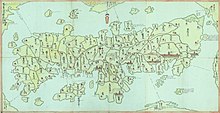Fukuyama Domain
Appearance
| Fukuyama Domain 福山藩 | |
|---|---|
| Domain of Japan | |
| 1619–1698 1700–1871 | |
| Capital | Fukuyama Castle |
| • Type | Daimyō |
| Historical era | Edo period |
• Established | 1619 |
• Disestablished | 1871 |
| Today part of | Hiroshima Prefecture |

Fukuyama Domain (福山藩, Fukuyama-han) was a Japanese domain of the Edo period. It was associated with Bingo Province and Bitchū Province in modern-day Hiroshima Prefecture.[1]
In the han system, Fukuyama was a political and economic abstraction based on periodic cadastral surveys and projected agricultural yields.[2] In other words, the domain was defined in terms of kokudaka, not land area.[3] This was different from the feudalism of the West.
List of daimyōs
The hereditary daimyōs were head of the clan and head of the domain.
- Mizuno clan, 1619–1698 (fudai; 101,000 koku)[4]
- Katsunari
- Katsutoshi
- Katsusada
- Katsutane
- Katsumine
- Tenryō, 1698–1700.
- Matsudaira (Okudaira) clan, 1700–1710 (fudai; 100,000 koku)[5]
- Tadamasa
- Masakuni
- Masayoshi
- Masasuke
- Masatomo
- Masakiyo
- Masayasu
- Masahiro
- Masanori
- Masakata
- Masatake
See also
References

- ^ "Bingo Province" at JapaneseCastleExplorer.com; retrieved 2013-4-28.
- ^ Mass, Jeffrey P. and William B. Hauser. (1987). The Bakufu in Japanese History, p. 150.
- ^ Elison, George and Bardwell L. Smith (1987). Warlords, Artists, & Commoners: Japan in the Sixteenth Century, p. 18.
- ^ Papinot, Jacques Edmond Joseph. (1906). Dictionnaire d’histoire et de géographie du Japon; Papinot, (2003). "Mizuno" at Nobiliare du Japon, pp. 35–36 [PDF 39-40 of 80]; retrieved 2013-4-28.
- ^ Papinot, (2003). "Matsudaira (Okudaira)" at Nobiliare du Japon, pp. 31–32 [PDF 36-37 of 80]; retrieved 2013-4-28.
- ^ Papinot, (2003). "Abe" at Nobiliare du Japon, p. 1 [PDF 5 of 80]; retrieved 2013-4-28.
External links
- "Fukuyama" at Edo 300 Archived 2016-03-03 at the Wayback Machine (in Japanese)
